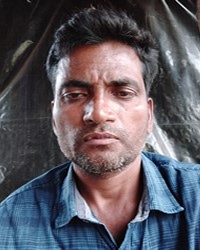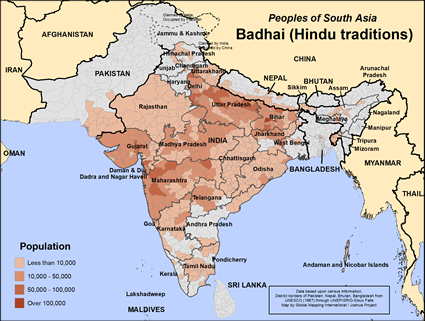Badhai (Hindu traditions) in India

Photo Source:
Anonymous
|

Map Source:
People Group Location: Omid. Other geography / data: GMI. Map Design: Joshua Project
|
| People Name: | Badhai (Hindu traditions) |
| Country: | India |
| 10/40 Window: | Yes |
| Population: | 6,675,000 |
| World Population: | 6,737,000 |
| Primary Language: | Hindi |
| Primary Religion: | Hinduism |
| Christian Adherents: | 0.01 % |
| Evangelicals: | 0.00 % |
| Scripture: | Complete Bible |
| Ministry Resources: | Yes |
| Jesus Film: | Yes |
| Audio Recordings: | Yes |
| People Cluster: | South Asia Hindu - Badhai |
| Affinity Bloc: | South Asian Peoples |
| Progress Level: |
|
Introduction / History
The Badhai are also known as the Vishwakarma. They are successors of Vishwakarma, the chief architect in Hindu culture. In ancient times, Vishwakarma were described as saints involved in meditation for inner vision and performing scientific experiments for the betterment of others. They enjoyed the status of engineers and architects in Indian cities and towns. Ancient Indian art and culture, particularly building temples, and chariots were built by the Badhai, or Vishwakarma. They created various idols and images of Hindu gods and goddesses to be worshiped by all. The Badhai provided sketches or blueprints for builders in making Hindu temples. The Badhai live today in most areas of India. Their primary language is Hindi. Many also speak English and the local languages where they live.
What Are Their Lives Like?
Today the inherited craftsmanship and skills of the Badhai are less required than in ancient times. Thus they are losing a degree of status. Manual labor or farm work is not an option to a Badhai or Vishwakarma as they have high self-esteem. Most Badhai are still employed in the fields of engineering, education, small-scale industrial manufacturing, and doing engineering work for large industries. Some Badhai work in the areas of the building trades. Beyond their traditional roles in architecture and religious art, the Badhai community is also engaged in various crafts involving gold, silver, copper, iron, and stone.
What Are Their Beliefs?
The Badhai worship and serve the gods of the Hindu pantheon. Hindus believe that by performing rituals and good works that they will attain "moksha" or freedom from the endless cycle of birth, death and rebirth. The Badhai visit Hindu temples and offer prayers, food, flowers, and incense to their gods in hopes of gaining protection and benefits. They do not have a personal or familial relationship with their gods as Christians do. There are many forms of Hinduism, each with its own deities and beliefs. The main yearly holidays of the Badhai people are Holi, the festival of colors and the start of spring, Diwali, the festival of lights, Navratri, the celebration of autumn and Rama Navami, Rama's birthday. The caste system divides Hindus into four main categories. The lowest communities are outside of the caste system.
What Are Their Needs?
The Badhai need to see themselves as sinners in need of a Savior. Their pride in their Hindu traditions can prevent them from coming to a true knowledge of God.
Prayer Points
Pray for the Lord to send out higher caste Indian believers to tell the Badhai about the Lord.
Pray for Badhais to be filled with wisdom, knowledge, and understanding from God as he did with Bezalel in Scripture, so that they may become holy vessels for the Lord's purposes—creating works that reflect God's beauty and goodness.
Pray that God would raise up mature believers among them—mentors who can walk with them Badhai in their daily lives and workplaces, teaching them to follow and depend on Christ.